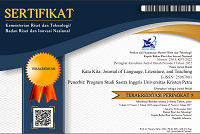The Perceived Meanings of Tokopedia Advertisement Video, “Berikan yang Paling Berarti untuk yang Berarti”
(1) Petra Christian University, Jl. Siwalankerto No.121-131, Siwalankerto, Wonocolo, Surabaya
(*) Corresponding Author
Abstract
Delivering a message from an advertisement is important to know whether the message that a company wants to transfer is well-delivered or not because the background of audiences may affect them in interpreting the message. Thus, the writer aims to the writer aims to discover how background education affects people to produce information by observing the perceived meanings produced by English Department respondents and Engineering Department respondents. To do so, the writer uses verbal and non-verbal communications Tokopedia "Berikan yang Paling Berarti untuk yang Berarti" advertisement video. The writer applies Saussure's process of signification and Peirce's three sign mode to analyze the perceived meanings from the respondents. Based on the analysis, the writer discovers all respondents mainly use symbolic mode in producing messages which means the respondents interpret the data by relating it with their personal association. Nonetheless, Engineering Department's respondents use indexical mode more often than English Department's respondents in producing some meanings. Thus, the writer sees that English Department respondents mostly produce moral messages while Engineering Department respondents just mention the storyline. In conclusion, background knowledge indeed affects people to perceive meanings.
Keywords: Process of Signification, Perceived Meaning, Verbal and Non-verbal Communication.
Full Text:
PDFReferences
Busen, S. M. S., & Mustaffa, C. S. (2014). The Role of Interactive Advertisements in Developing Consumer-based Brand Equity: A Conceptual Discourse. Procedia - Social and behavioral sciences, 155, 98–103. doi: 10.1016/j.sbspro.2014.10.263
Chandler, D. (2007). Semiotics: The basics (2nd ed.). New York, USA: Routledge.
Gunawan, H. (2018, February 18). Ini pesan penting kampanye iklan tokopedia terbaru garapan flock untuk pemuda Indonesia. Retrieved from https://www.tribunnews.com/techno/2018/02/18/ini-pesan-penting-kampanye-iklan-tokopedia-terbaru-garapan-flock-untuk-pemuda-indonesia.
Leo, M. (2017). A Semiotic Analysis on The Perceived Meanings of Coca Cola “Anthem” Video Commercial. K@ta kita, 5(1), 8-14. doi:10.9744/katakita/5/1/8.14
Mustansyir, R. (2003). Refleksi filosofis atas pekermbangan ilmu-Ilmu humaniora. Jurnal Filsafat 13(3), 209-217. https://jurnal.ugm.ac.id/wisdom/article/view/31794
Petrina, I. A. (2019). Natural White Pinkish Fairness Advertisement. K@ta kita, 7(1), 56. doi 10.9744/katakita.7.1.56-63
Saputra, F. D. (2017). The Concept of Happiness in DJarum 76 “Yang Penting Hepii..”. K@ta kita, 5(2), 27-37. doi 10.9744/katakita.5.2.27-37
Schreier, M. (2012). Qualitative content analysis in practice. London: SAGE Publications Ltd.
Woodside, A. G. (2010). Brand-customer storytelling theory and research: Introduction to a psychology & marketing special issue. Psychology and marketing, 27(6), 531-5540/ doi:10.1002/mar.20342
DOI: https://doi.org/10.9744/katakita.9.1.98-106
Refbacks
- There are currently no refbacks.
Supported by:
Indexed in:
Tools:
Stats (installed since 17 December 2018)
View My Stats













